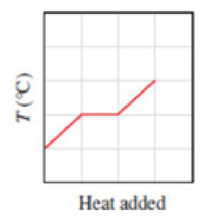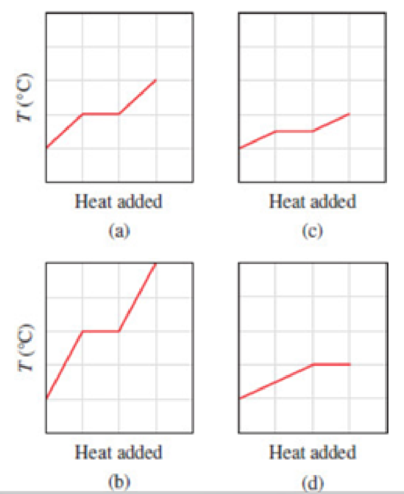
Chemistry: Atoms First
2nd Edition
ISBN: 9780073511184
Author: Julia Burdge, Jason Overby Professor
Publisher: McGraw-Hill Education
expand_more
expand_more
format_list_bulleted
Concept explainers
Textbook Question
Chapter 12, Problem 12.126QP
A sample of water shows the following behavior as it is heated at a constant rate.

If twice the mass of water has the same amount of heat transferred to it, which of the graph -(d)] best describes the temperature variation? Note that the scales for all the graphs are same.

Expert Solution & Answer
Want to see the full answer?
Check out a sample textbook solution
Students have asked these similar questions
5. A buffer consists of 0.45 M NH, and 0.25 M NH-CI (PK of NH 474) Calculate the pH of the butter. Ans: 9.52
BAS
PH-9.26 +10g (10.95))
14-4.59
PH=4.52
6. To 500 ml of the buffer on #5 a 0.20 g of sample of NaOH was added
a Write the net ionic equation for the reaction which occurs
b. Should the pH of the solution increase or decrease sightly?
Calculate the pH of the buffer after the addition Ans: 9.54
Explain the inductive effect (+I and -I) in benzene derivatives.
The inductive effect (+I and -I) in benzene derivatives, does it guide ortho, meta or para?
Chapter 12 Solutions
Chemistry: Atoms First
Ch. 12.2 - Prob. 12.1WECh. 12.2 - Prob. 1PPACh. 12.2 - Prob. 1PPBCh. 12.2 - The diagram on the left depicts a system at room...Ch. 12.2 - Prob. 12.2.1SRCh. 12.2 - Prob. 12.2.2SRCh. 12.2 - Prob. 12.2.3SRCh. 12.2 - Prob. 12.2.4SRCh. 12.3 - Prob. 12.2WECh. 12.3 - When silver crystallizes, it forms face-centered...
Ch. 12.3 - The density of sodium metal is 0.971 g/cm3 and the...Ch. 12.3 - Prob. 12.3.1SRCh. 12.3 - Prob. 12.3.2SRCh. 12.4 - How many of each ion are contained within a unit...Ch. 12.4 - Referring to Figure 12.23, determine how many of...Ch. 12.4 - Referring to Figure 12.23, determine how many of...Ch. 12.4 - Prob. 3PPCCh. 12.4 - The edge length of the NaCl unit cell is 564 pm....Ch. 12.4 - Prob. 4PPACh. 12.4 - NiO also adopts the face-centered cubic...Ch. 12.4 - The metal iridium (Ir) crystallizes with a...Ch. 12.4 - Prob. 5PPACh. 12.4 - Copper crystallizes in a face-centered cubic...Ch. 12.4 - Given that the diameter and average mass of a...Ch. 12.5 - (a) Calculate the amount of heat deposited oil the...Ch. 12.5 - Calculate the amount of energy (in kilojoules)...Ch. 12.5 - Determine the final state and temperature of 100 g...Ch. 12.5 - Prob. 6PPCCh. 12.5 - Prob. 12.5.1SRCh. 12.5 - Prob. 12.5.2SRCh. 12.6 - Using the following phase diagram, (a) determine...Ch. 12.6 - Use the following phase diagram to (a) determine...Ch. 12.6 - Prob. 7PPBCh. 12.6 - Prob. 7PPCCh. 12.6 - Prob. 12.6.1SRCh. 12 - Explain why liquids, unlike gases, are virtually...Ch. 12 - What is surface tension? What is the relationship...Ch. 12 - Prob. 12.3QPCh. 12 - Prob. 12.4QPCh. 12 - Prob. 12.5QPCh. 12 - Prob. 12.6QPCh. 12 - Prob. 12.7QPCh. 12 - Why does the viscosity of a liquid decrease with...Ch. 12 - Why is ice less dense than water?Ch. 12 - Prob. 12.10QPCh. 12 - Prob. 12.11QPCh. 12 - Prob. 12.12QPCh. 12 - Prob. 12.13QPCh. 12 - Predict which of the following liquids has greater...Ch. 12 - Prob. 12.15QPCh. 12 - Vapor pressure measurements at several different...Ch. 12 - The vapor pressure of liquid X is lower than that...Ch. 12 - Prob. 12.18QPCh. 12 - Prob. 12.19QPCh. 12 - Define the following terms: crystalline solid,...Ch. 12 - Prob. 12.21QPCh. 12 - Classify the solid states in terms of crystal...Ch. 12 - Prob. 12.23QPCh. 12 - Define X-ray diffraction. What are the typical...Ch. 12 - Prob. 12.25QPCh. 12 - What is the coordination number of each sphere in...Ch. 12 - Calculate the number of spheres that would be...Ch. 12 - Prob. 12.28QPCh. 12 - Barium metal crystallizes in a body-centered cubic...Ch. 12 - Prob. 12.30QPCh. 12 - Europium crystallizes in a body-centered cubic...Ch. 12 - Crystalline silicon has a cubic structure. The...Ch. 12 - Prob. 12.33QPCh. 12 - Prob. 12.34QPCh. 12 - Prob. 12.35QPCh. 12 - Prob. 12.36QPCh. 12 - Shown here is a zinc oxide unit cell. What is the...Ch. 12 - Describe and give examples of the following types...Ch. 12 - Prob. 12.39QPCh. 12 - A solid is hard, brittle, and electrically...Ch. 12 - A solid is soft and has a low melting point (below...Ch. 12 - Prob. 12.42QPCh. 12 - Which of the following are molecular solids and...Ch. 12 - Prob. 12.44QPCh. 12 - Prob. 12.45QPCh. 12 - What is a phase change? Name all possible changes...Ch. 12 - What is the equilibrium vapor pressure of a...Ch. 12 - Use any one of the phase changes to explain what...Ch. 12 - Define the following terms: (a) molar heat of...Ch. 12 - Prob. 12.50QPCh. 12 - What can we learn about the intermolecular forces...Ch. 12 - The greater the molar heat of vaporization of a...Ch. 12 - Prob. 12.53QPCh. 12 - A closed container of liquid pentane (bp = 36.1C)...Ch. 12 - What is critical temperature? What is the...Ch. 12 - Prob. 12.56QPCh. 12 - How do the boiling points and melting points of...Ch. 12 - Prob. 12.58QPCh. 12 - Prob. 12.59QPCh. 12 - Prob. 12.60QPCh. 12 - Which of the following phase transitions gives off...Ch. 12 - Prob. 12.62QPCh. 12 - Prob. 12.63QPCh. 12 - Prob. 12.64QPCh. 12 - Prob. 12.65QPCh. 12 - Prob. 12.66QPCh. 12 - Prob. 12.67QPCh. 12 - How is the rate of evaporation of a liquid...Ch. 12 - Explain why steam at 100C causes more serious bums...Ch. 12 - The following compounds, listed with then- boiling...Ch. 12 - Prob. 12.71QPCh. 12 - Prob. 12.72QPCh. 12 - Explain how waters phase diagram differs from...Ch. 12 - The blades of ice skates are quite thin, so the...Ch. 12 - A length of wire is placed on top of a block of...Ch. 12 - Prob. 12.76QPCh. 12 - A phase diagram of water is shown. Label the...Ch. 12 - Prob. 12.78QPCh. 12 - Prob. 12.79QPCh. 12 - Prob. 12.80QPCh. 12 - Prob. 12.81QPCh. 12 - Prob. 12.82QPCh. 12 - The average distance between base pairs measured...Ch. 12 - A CO2 fire extinguisher is located on the outside...Ch. 12 - What is the vapor pressure of mercury at its...Ch. 12 - Prob. 12.86QPCh. 12 - The liquid-vapor boundary line in the phase...Ch. 12 - Prob. 12.88QPCh. 12 - Prob. 12.89QPCh. 12 - A student is given four solid samples labeled W,...Ch. 12 - Prob. 12.91QPCh. 12 - The diagram shows a kettle of boiling water....Ch. 12 - The south pole of Mars is covered with solid...Ch. 12 - The properties of gases, liquids, and solids...Ch. 12 - The standard enthalpy of formation of gaseous...Ch. 12 - Prob. 12.96QPCh. 12 - Under the same conditions of temperature and...Ch. 12 - The distance between Li+ and Cl is 257 pm in solid...Ch. 12 - Heat of hydration, that is, the heat change that...Ch. 12 - The fluorides of the second period elements and...Ch. 12 - Calculate the H for the following processes at...Ch. 12 - Prob. 12.102QPCh. 12 - Prob. 12.103QPCh. 12 - Ozone (O3) is a strong oxidizing agent that can...Ch. 12 - A sample of limestone (CaCO3) is heated in a...Ch. 12 - Carbon and silicon belong to Group 4A of the...Ch. 12 - Prob. 12.107QPCh. 12 - A 1.20-g sample of water is injected into an...Ch. 12 - What are the advantages of cooking the vegetable...Ch. 12 - A quantitative measure of how efficiently spheres...Ch. 12 - The phase diagram of helium is shown. Helium is...Ch. 12 - The phase diagram of sulfur is shown. (a) How many...Ch. 12 - Prob. 12.113QPCh. 12 - Argon crystallizes in the face-centered cubic...Ch. 12 - Given the phase diagram of carbon, answer the...Ch. 12 - Prob. 12.116QPCh. 12 - Swimming coaches sometimes suggest that a drop of...Ch. 12 - Prob. 12.118QPCh. 12 - Why do citrus growers spray their trees with water...Ch. 12 - Calcium metal crystallizes in a face-centered...Ch. 12 - A student heated a beaker of cold water (on a...Ch. 12 - The compound diclilorodifluoromethane (CCl2F2) has...Ch. 12 - Iron crystallizes in a body-centered cubic...Ch. 12 - Sketch the cooling curves of water from about 110C...Ch. 12 - Prob. 12.125QPCh. 12 - A sampleof water shows the following behavior as...Ch. 12 - A closed vessel of volume 9.6 L contains 2.0 g of...Ch. 12 - The electrical conductance of copper metal...Ch. 12 - Assuming ideal behavior, calculate the density of...Ch. 12 - Explain why drivers are advised to use motor oil...Ch. 12 - Prob. 12.131QPCh. 12 - Silicon used in computer chips must have an...Ch. 12 - Prob. 12.133QPCh. 12 - Prob. 12.1KSPCh. 12 - Prob. 12.2KSPCh. 12 - Prob. 12.3KSPCh. 12 - Prob. 12.4KSP
Knowledge Booster
Learn more about
Need a deep-dive on the concept behind this application? Look no further. Learn more about this topic, chemistry and related others by exploring similar questions and additional content below.Similar questions
- 19.57 Using one of the reactions in this chapter, give the correct starting material (A-L) needed to produce each structure (a-f). Name the type of reaction used. (b) ہ مرد (d) HO (c) དང་ ་་ཡིན་ད་དང་ (f) HO Br B D of oli H J Br K C 人 ↑arrow_forwardInductive effect (+I and -I) in benzene derivatives.arrow_forward7. Helparrow_forward
arrow_back_ios
SEE MORE QUESTIONS
arrow_forward_ios
Recommended textbooks for you
 Chemistry by OpenStax (2015-05-04)ChemistryISBN:9781938168390Author:Klaus Theopold, Richard H Langley, Paul Flowers, William R. Robinson, Mark BlaserPublisher:OpenStax
Chemistry by OpenStax (2015-05-04)ChemistryISBN:9781938168390Author:Klaus Theopold, Richard H Langley, Paul Flowers, William R. Robinson, Mark BlaserPublisher:OpenStax World of Chemistry, 3rd editionChemistryISBN:9781133109655Author:Steven S. Zumdahl, Susan L. Zumdahl, Donald J. DeCostePublisher:Brooks / Cole / Cengage Learning
World of Chemistry, 3rd editionChemistryISBN:9781133109655Author:Steven S. Zumdahl, Susan L. Zumdahl, Donald J. DeCostePublisher:Brooks / Cole / Cengage Learning Living By Chemistry: First Edition TextbookChemistryISBN:9781559539418Author:Angelica StacyPublisher:MAC HIGHER
Living By Chemistry: First Edition TextbookChemistryISBN:9781559539418Author:Angelica StacyPublisher:MAC HIGHER Introductory Chemistry: An Active Learning Approa...ChemistryISBN:9781305079250Author:Mark S. Cracolice, Ed PetersPublisher:Cengage Learning
Introductory Chemistry: An Active Learning Approa...ChemistryISBN:9781305079250Author:Mark S. Cracolice, Ed PetersPublisher:Cengage Learning Introductory Chemistry: A FoundationChemistryISBN:9781337399425Author:Steven S. Zumdahl, Donald J. DeCostePublisher:Cengage Learning
Introductory Chemistry: A FoundationChemistryISBN:9781337399425Author:Steven S. Zumdahl, Donald J. DeCostePublisher:Cengage Learning

Chemistry by OpenStax (2015-05-04)
Chemistry
ISBN:9781938168390
Author:Klaus Theopold, Richard H Langley, Paul Flowers, William R. Robinson, Mark Blaser
Publisher:OpenStax

World of Chemistry, 3rd edition
Chemistry
ISBN:9781133109655
Author:Steven S. Zumdahl, Susan L. Zumdahl, Donald J. DeCoste
Publisher:Brooks / Cole / Cengage Learning

Living By Chemistry: First Edition Textbook
Chemistry
ISBN:9781559539418
Author:Angelica Stacy
Publisher:MAC HIGHER

Introductory Chemistry: An Active Learning Approa...
Chemistry
ISBN:9781305079250
Author:Mark S. Cracolice, Ed Peters
Publisher:Cengage Learning

Introductory Chemistry: A Foundation
Chemistry
ISBN:9781337399425
Author:Steven S. Zumdahl, Donald J. DeCoste
Publisher:Cengage Learning

Types of Matter: Elements, Compounds and Mixtures; Author: Professor Dave Explains;https://www.youtube.com/watch?v=dggHWvFJ8Xs;License: Standard YouTube License, CC-BY